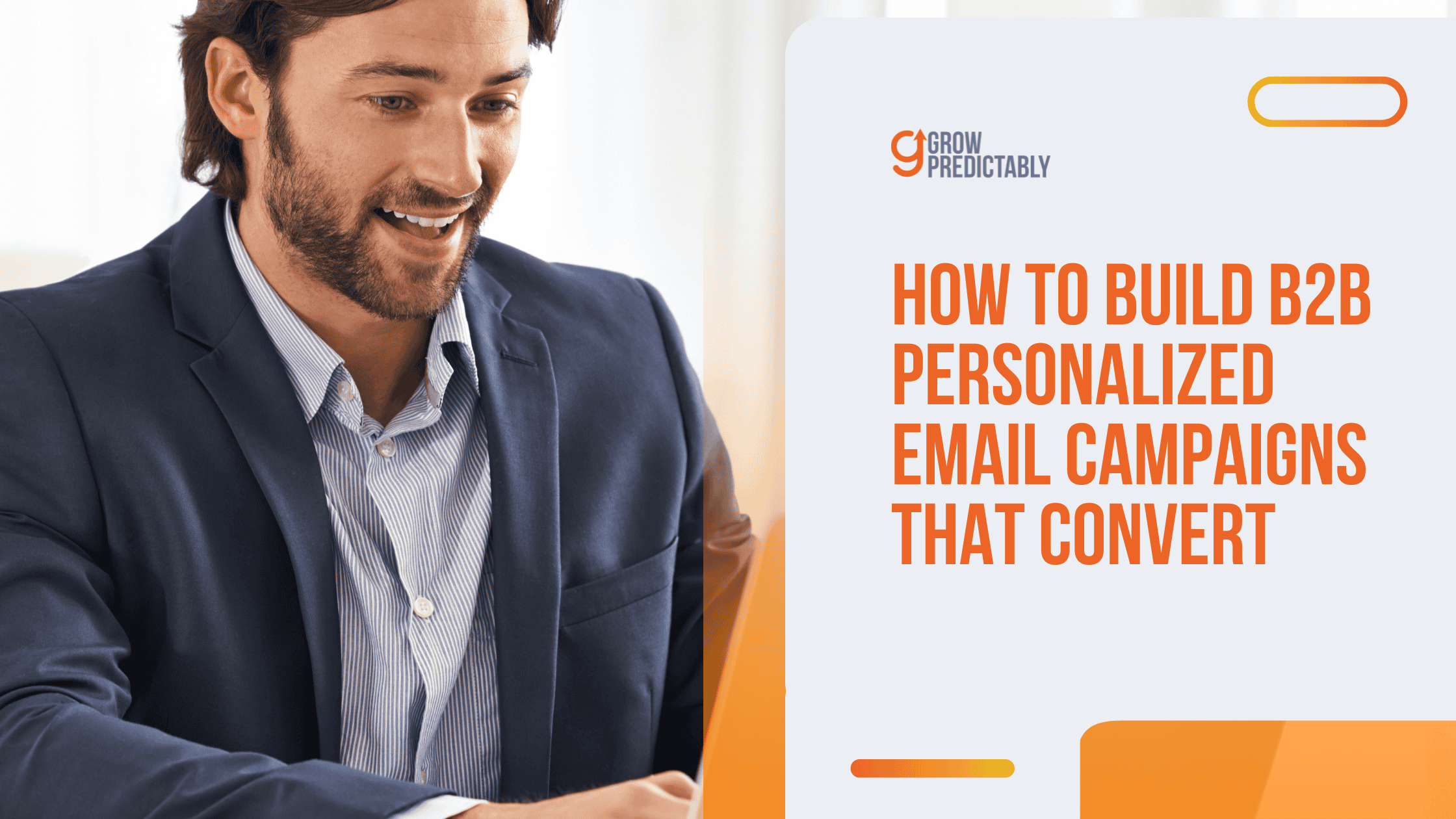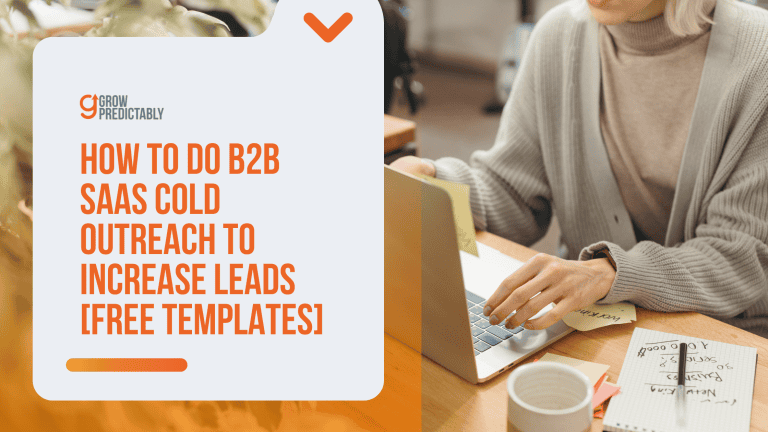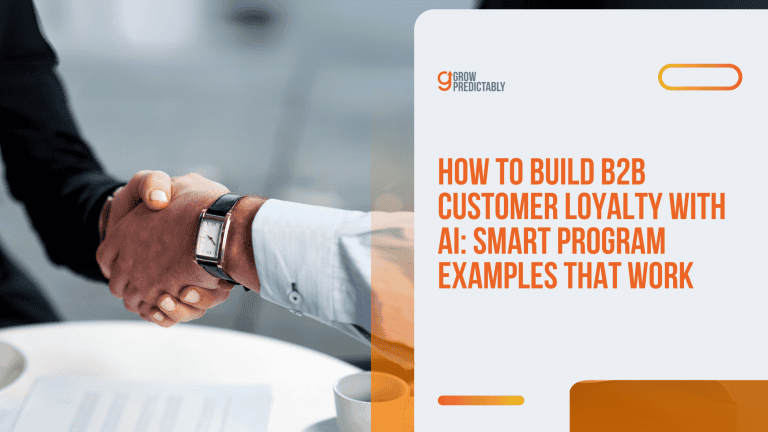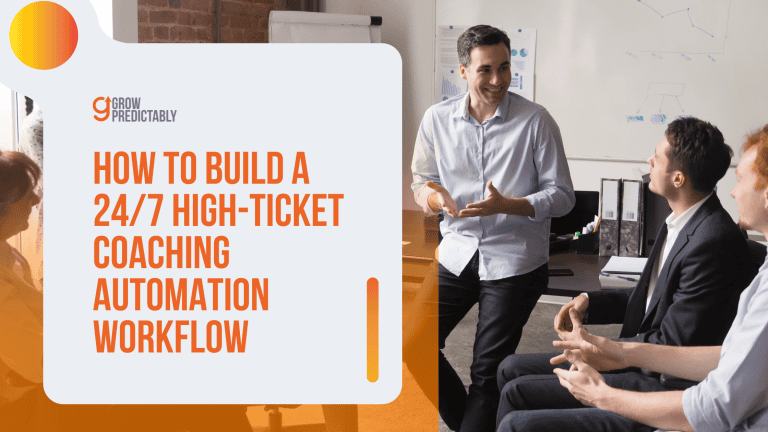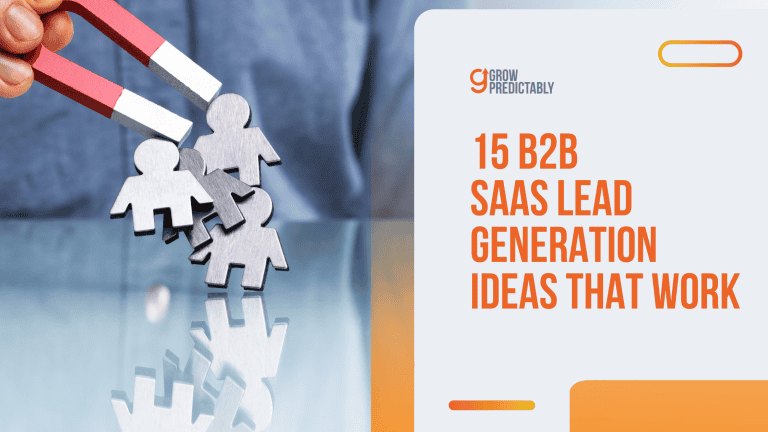How to Build B2B Personalized Email Campaigns That Convert
You built your list. Wrote a few clever subject lines. Hit “send to all”… and got barely a pulse.
If you’re wondering why your personalized email campaigns for B2B aren’t converting, the problem isn’t email—it’s the structure behind it.
When one B2B SaaS company layered industry-segmented messaging on firmographic data, they boosted their demo bookings by 38%—in six weeks.
This isn’t about “Dear [FIRSTNAME]” tactics.
It’s about unlocking insights your competitors missed by using segmentation and behavioral data the right way.
Want to know what they changed—and how you can do it in hours, not months?
Let’s dig in.
6-Step Guide to Effective Personalization for B2B Email Campaigns
Want to boost your demo bookings with B2B email marketing?
I’m about to show you how to create email campaigns that speak directly to your B2B prospects’ needs and pain points.
By the end of this guide, you’ll have a clear roadmap for building targeted email marketing campaigns that convert.
No more spray-and-pray emails – we’re talking about messages that make your prospects think, “This company gets me.”
Let’s break this down into bite-sized personalization strategies you can start using today:
Step 1: Define Your Campaign Goal
This step is the most common and the step that comes before everything else.
Pick one clear objective; focused goals increase your email marketing efficiency and accountability.
Example: Let’s say your primary goal is to increase demo bookings for your workflow automation SaaS tool among marketing agencies.
How to Apply:
- Document the goal and communicate this with the entire team to remain consistent.
- Align every email copy and CTA (call-to-action) to push for demo bookings, not just “awareness.”
A CRM platform with goal-tracking (like HubSpot or Salesforce) helps keep everyone accountable during this step.
Also, don’t forget to use the SMART criteria (Specific, Measurable, Achievable, Relevant, Time-bound) to clarify your goal.

Example:
- Book 30 demos from mid-sized agencies in the next 6 weeks.
- Secure 20 consultation calls with healthcare companies in Q2.
- Increase free trial sign-ups among SaaS startups by 25% this month.
- Grow our newsletter list by 500 marketing decision-makers in the next 60 days.
- Schedule 15 product walkthroughs with enterprise IT managers before the end of the quarter.
Step 2: Build Your Customer Avatars
The key to personalizing anything is knowing who your target audience is. It doesn’t have to be personally, but with data, you can get close to your potential customers.
Dig into your existing customer base.
You can’t just assume all agencies need the same features—you need to dig into specifics.
Try interviewing three happy agency clients to understand why they chose your solution, review your CRM for top-performing agency segments, chat with your sales team about common objections, and analyze support tickets for recurring issues.
How to Apply:
- Create a worksheet including details, such as agency size, pain points, and workflow bottlenecks.
- Conduct quick phone interviews; ask “What nearly stopped you from signing up?”
- Use LinkedIn and social listening tools to supplement your research.
Use AI tools like ChatGPT to generate draft avatars based on your best-fit clients.
Ongoing avatar refresh at least twice yearly is also highly recommended to keep up with market shifts.
Boost Your Results with the Customer Avatar Canvas
To make this process even easier and more effective, leverage the Customer Avatar Canvas—a practical framework designed to organize your research and ensure no critical detail is overlooked.
This canvas is designed to help you track every detail you need to remember about your customer or avatar.

Here’s how the canvas can streamline and enhance each part of this step:
- Centralized Data Collection:
List insights from interviews, CRM analytics, sales, and support in dedicated sections (demographics, frustrations, motivations, objections) within the canvas for easy reference. - The Before/After Transformation:
Map your avatar’s journey using the canvas’s unique “Before/After” feature. Record what their workflow and pain points looked like before your solution, and what success looks like after using your product—this clarity is essential for personalized messaging. - Identify Content and Product Gaps:
By visualizing all customer insights in one template, you can spot unmet needs or opportunities for new features, campaign angles, or relevant content. - Quick Refreshes and Team Collaboration:
The canvas makes avatar updates efficient—simply revisit and tweak sections after gathering new intel, ensuring your marketing stays relevant as your market evolves.
When updating avatars biannually, use the canvas to quickly compare shifts in customer needs, keeping your marketing targeted and up-to-date.
By leveraging the Customer Avatar Canvas into your avatar-building process, you’ll save time, boost clarity, and ensure your campaigns are always aligned with real customer needs and aspirations.
Step 3: Segment Your Audience
After identifying the avatars for your email marketing campaign, split your list based on relevant criteria that reflect your target audience.
This helps segment your email lists and increase your chances of improving your open rates by 46%. (Source)
Segment your list by agency size (20–100 employees), current workflow tools (e.g., using Trello or Asana), and behaviors (e.g., visited your pricing page in the last month, or engaged with a recent webinar) to better target your potential customers.
Good segmentation is only possible with up-to-date, reliable data (company size, industry, roles, recent behaviors, etc.).
Review and clean your list regularly, and focus on analyzing data patterns to find opportunities for better targeting.
But, remember also to avoid splitting your list so much that segments become too small or your messaging gets too complicated to manage.
How to Apply:
- Use your email marketing platform’s advanced filters for list segmentation.
- Sync behavioral data from your website analytics (e.g., Google Analytics or Hotjar) into your CRM/email tool.
Start simple—segment using just one variable (such as industry) and A/B test your messaging.
PRO TIP: Tools like Mailchimp and ActiveCampaign offer dynamic segment features that automatically sort your subscribers as new data comes in.
Step 4: Identify Purchase Drivers
Map out what moves your segments to act.
It’s not always just financial ROI; operational and emotional pain points drive actions, too!
For marketing agencies, your interviews reveal purchase drivers like the need for time-saving automation due to understaffing, compliance pressures with client data, or demand for scalable solutions as clients grow.
Listen very closely to these signals, as these can help with your personalization and segmentation efforts.
How to Apply:
- Start by referring to your Customer Avatar Canvas.
- Review your interview notes and support tickets to uncover real examples of what drives each type of customer to take action.
- List the top 3 specific purchase drivers for each segment or persona using the canvas.
- For each driver, write an example “problem-outcome duo” (such as “Manual reporting = 5 wasted hours/week → Automated reports = 2-hour saving/week”).
- Use simple language from your customers when describing these drivers and outcomes.
- Double-check that your email messaging and campaign content always links back to at least one of these main motivators.
- Revisit and update your purchase drivers regularly to stay aligned with shifting customer needs.
One survey from Gartner reveals that 86% of B2B buyers expect companies to be well-informed about their critical information during interactions. (Source)
This data supports the obvious need for B2B brands to be knowledgeable about the different factors that influence their consumers’ purchasing decisions.
Step 5: Craft Your Hook
Even personalized emails need to effectively hook their targets first for the outreach to serve its purpose.
To do that, turn frustrations into compelling personalized subject lines and openers.
Examples:
- “Tired of manual data entry? Here’s a 2-minute fix.”
- “Your competitors automated this last quarter.”
- “Stop losing deals to compliance issues.”
How to Apply:
- Use your avatar’s actual language from interviews (“I just want to stop chasing spreadsheets every Friday”).
- Reference your avatar’s pain points in your Customer Avatar Canvas.
- Test 3–5 personalized subject lines via split test before the final send.
A quick hack is using ChatGPT or Jasper to brainstorm 10 variants in your customers’ tone of voice. Tools like CoSchedule Headline Analyzer can also score your subject lines for impact.
Subject line personalization is key to increasing open rates and drawing in segmented audiences.
Always consider how different subject lines appeal to each segment. Don’t use clickbait; make sure the hook ties directly to the email content.
Copywriting expert Joanna Wiebe (Copyhackers) emphasizes empathy: “The more I respect the reader’s anxieties, motivations, and context, the more likely they are to trust me. And trust? That’s what drives conversion.”
Step 6: Map the Journey
Show the transformation from pain to solution along the customer journey.
| Before | After |
|---|---|
| Struggling with manual processes | Saving 15 hours per week with automation |
Don’t assume prospects will “connect the dots” on their own. Spell out the before/after.
How to Apply:
- Draft a simple storyboard: pain ➔ trigger ➔ solution ➔ outcome.
- Build a 3-part email sequence:
Email 1: “Thanks for downloading our ROI calculator – here’s what it revealed for Company X (similar agency).”
Email 2: “See how [Industry Peer] doubled their output with automation.”
Email 3: “Ready for your custom efficiency audit?”
You can also embed a short 60-second video testimonial from a current client. Visual proof accelerates trust!
SaaS leaders, including HubSpot and Intercom, use storytelling sequences to nudge prospects across the funnel.
PRO TIP: Loom or Vidyard helps you quickly send personalized video follow-ups.
Bringing It All Together: One Example Across All Steps
Let’s see how these steps tie up in a hypothetical B2B scenario:
Goal? Get 30 demo bookings from mid-sized agencies in 6 weeks.
Avatar? Agencies using Trello, 20–100 employees, are bottlenecked by manual status reporting.
Segment? Agencies that attended your “Automate Your Monday” webinar are showing intent.
Driver? Desire to free up weekly admin hours for more billable creative work.
Hook? “How [Peer Agency] reclaimed 15 hours/week (and won more clients).”
Journey?
- Email 1: Customized ROI insights (“just for you!”)
- Email 2: Short case study—how a similar agency achieved 3x the results
- Email 3: Direct, personal invite to book a 1:1 workflow audit
Now, instead of guessing, you’re guiding every prospect step-by-step, with every email marketing rooted in what matters most to them.
Remember, personalization is not just about “Dear {{firstname}}”—it’s about making every touchpoint feel like it was built for your prospect, by someone who’s walked in their shoes.
Your Essential Toolkit
- CRM enrichment: Clearbit or ZoomInfo
- Email automation: HubSpot or ActiveCampaign
- Copy creation: Jasper or Copy.ai
- Performance tracking: GA4 or HubSpot Reporting
Ready to watch your demo rates climb?
Start building your first triggered email marketing campaign today – segment your list, craft personal messages, and test your results.
Remember: Your prospects don’t care about features – they care about solving their problems.
Make every email show them you understand their challenges and have the solution they need—this is the power of personalized email marketing and advanced personalization strategies.
The next section breaks down advanced segmentation strategies that’ll help you fine-tune your targeting even further.
A Closer Look at Four Segmentation Strategies
Imagine this scenario.
You’re sending the same email to every B2B prospect, hoping something sticks.
But what if you could speak directly to the unique needs of your potential customers?
That’s where smart segmentation comes in.
Earlier, we talked about how you can get started segmenting your targets.

Now, let’s further break down how you can group your audience for maximum impact through four power-packed methods for segmenting your B2B lists.
1. Firmographic Segmentation
Think of this as your company-level filter.
You’ll group prospects by:
- Company size (e.g., startups vs enterprise)
- Industry focus
- Annual revenue
- Geographic location
For example, you might create a segment for “Mid-market healthcare companies with $10M+ revenue in the Northeast.”
2. Behavioral Segmentation
This tracks what your prospects actually do:
- Downloaded your security whitepaper
- Visited the pricing page multiple times
- Watched your product demo
- Abandoned a quote request
3. Role-Based (Demographic) Segmentation
Not all decision-makers are created equal.
Split by:
- Job titles (CTO vs CMO)
- Department (IT vs Marketing)
- Decision-making authority
- Budget control level
4. Technographic Segmentation
What tech stack are they using?
This helps you:
- Spot integration opportunities
- Identify tech-based pain points
- Target companies using competitor solutions
Making Your Segments Work Harder
Here’s a real-world example:
Starting Point: “Enterprise SaaS Prospects”
Refined Segment: “FinTech CTOs using legacy security systems who viewed compliance content”
Message Focus: “How modern security protocols reduce compliance overhead by 40%”
Want to put this into action?
Follow these steps:
- Pull your behavioral data from GA4
- Filter your CRM data (company size, industry, etc.)
- Add tech stack insights
- Match content to specific pain points
Remember: Good segments aren’t just lists – they’re micro-audiences with shared challenges waiting for solutions.
Quick Wins for Better Segmentation
✓ Start with 2-3 clear segments
✓ Test different messages per segment
✓ Track which segments convert best
✓ Refine based on response data
The proof is in the numbers: HubSpot’s 2023 research shows segmented B2B campaigns drive 14.31% higher open rates and double the clicks compared to broad-blast approaches.
Before you jump to the next section on automation tools, remember: Your segments are only as good as your understanding of who’s in them.
Take time to validate your groupings with your sales team – they’re on the front lines and know your customers best.
Next up: We’ll explore how to automate these segments for maximum impact without losing that personal touch.
Where Automation Comes In…
Do you want your personalized emails to reach the right person, at the perfect moment, with exactly what they need?
In personalizing your B2B email campaigns, automation is an element that cannot be overlooked.
I’ve seen companies struggle with manual follow-ups and generic messaging.
But here’s the truth: automation isn’t about removing the human touch – it’s about delivering personalized emails, messages, and experiences at scale.
Just like what this quote from Blue Prism CEO says…
Intelligent automation is about creating a digital workforce that collaborates with humans to drive innovation and efficiency.
Jason Kingdon, Chairman and CEO of Blue Prism
Let’s break this down into actionable steps:
Step 1: Create Segments in Your CRM
Start by grouping your contacts based on:
- Recent actions (demo requests, pricing page visits)
- Company size and industry
- Current tech stack
- Engagement level
Step 2: Pick Your Trigger Points
Set up automation triggers when prospects:
- Register for a demo
- Visit your pricing page multiple times
- Download specific resources
- Hit a certain lead score threshold
Step 3: Build Your Workflow
Create a sequence that makes sense:
- Welcome email with immediate value
- Industry-specific use cases
- Relevant customer stories
- Clear call-to-action
Step 4: Add AI-Powered Personalization
Use tools to enhance your message:
- Subject line optimization
- Industry-specific content blocks
- Behavioral-based recommendations
Step 5: Quality Check
Before launching:
- Test all personalization tokens
- Review tone consistency
- Check mobile responsiveness
- Verify trigger conditions
The key? Every automated touch should feel personal and valuable.
Think of automation as your scaling engine – it doesn’t replace human connection, it enhances it.
Ready to take the next step?
Your first automated sequence awaits.
Start small, test thoroughly, and watch your engagement soar.
PRE-LAUNCH CHECKLIST
Remember this checklist before launching:
✅ CRM connection verified
✅ Smart segments activated
☐ CTAs tested
☐ AI-generated copy reviewed
☐ Trigger conditions confirmed
Creating Dynamic Content with AI
Want to hear something exciting?
While most marketers send the same email to everyone, you can make each message feel personal and relevant using AI.
Delivering relevant content based on user data increases engagement and conversions.
Think about delivering content that adapts based on your prospect’s industry, tech stack, or even where they are in their buying journey!
Let’s break down how to make this happen.
First, dynamic content means your emails change based on what you know about each reader.
This approach lets you deliver personalized content that resonates with individual prospects.
Instead of “Dear Valued Customer,” you’re sending messages that speak to specific pain points and needs.
AI Tools for Dynamic Content
Here are the best tools to use for smoother dynamic content:
- Phrasee: Phrasee takes your subject lines from good to great using natural language processing. It learns what makes your audience click and adjusts accordingly.
- Persado: Persado helps craft preview text and body copy that matches your brand’s voice perfectly – especially handy for B2B where tone really matters.
- Jasper: Jasper creates full email sequences based on your audience insights. Feed it your customer data, and watch it generate targeted messages for different segments.
Your Game Plan
Ready to try this yourself?
Here’s your game plan:
- Connect the customer data in your CRM to your chosen AI tool.
- Let AI generate different content versions for each segment.
- Review everything – AI is smart but needs human oversight.
- Test different subject lines and content blocks.
- Roll out winners and keep measuring.
WARNING: While AI can do amazing things, don’t automate your calls-to-action blindly.
Always match CTAs to where prospects are in their journey.
A prospect who just downloaded a whitepaper needs different next steps than someone who’s viewed your pricing page three times.
CHECKLIST BEFORE SENDING
Before hitting send, check these boxes:
✅ Your CTA matches the prospect’s stage
✅ AI tool is properly connected to your data
☐ Personalization feels natural, not robotic
☐ Content speaks to specific industry challenges
REMEMBER: AI isn’t about removing the human touch – it’s about scaling personalization so each prospect feels understood.
When you nail this balance, you’ll see engagement soar.
Ready to make your personalized emails more dynamic?
Start small – pick one segment and one AI tool.
Test, learn, and grow from there.
Your prospects will thank you with their clicks and responses!
The Key Metrics and KPIs for Measuring Personalization in Email Campaigns
Imagine this scenario.
You’ve crafted perfect emails, but without tracking the right numbers, you’re flying blind.
Let’s focus on what really moves the needle in B2B email marketing campaigns and how your b2b email marketing strategy can deliver results.
First, we need to identify your key performance indicators across the funnel and customer journey to effectively measure your email marketing campaigns:
Top Funnel Metrics:
- Open rate (industry average: 21.5% for B2B)
- Click-through rate (CTR)
- Reply rate
- Time-to-first-response
Mid Funnel Metrics:
- Asset downloads
- Demo bookings
- Sales qualified leads (SQLs)
- Meeting show-up rate
Bottom Funnel Metrics:
- Sales opportunities created
- Conversion to customer
- Time to close
- Customer lifetime value (CLV)
Now, let’s get you started on setting up tracking:
- Connect GA4 enhanced measurement
- Set up UTM parameters for every email link
- Track both positive actions (clicks, replies) and negative signals (unsubscribes, spam reports)
- Calculate your campaign ROI using this simple formula:
ROI = (Revenue from Campaign – Campaign Cost) / Campaign Cost
Here’s a pro tip for you.
Don’t get lost in vanity metrics.
Focus on numbers that tie directly to revenue impact.
For instance, one of my clients was celebrating their 35% open rate but missing the fact that their demo booking rate was only 0.5%.
We shifted focus to optimizing their call-to-action placement and saw demo bookings jump to 2.3% within two weeks.
Quick Health Check Questions:
- Which email sequence drives the most qualified leads?
- Where do prospects typically ghost you in the funnel?
- What’s your cost per booked meeting?
- Which subject lines consistently outperform others?
Remember this.
Track trends over time, not just snapshot metrics.
A 5% increase in demo show-up rates often matters more than a 20% boost in opens.
Red Flags to Watch:
- Open rates below 15%
- CTR under 2%
- Unsubscribe rate above 0.5%
- Reply rate below 2% for direct outreach
Want to start tracking key metrics for your email marketing campaigns easily?
Here’s the bottom line.
You want numbers that tell stories about customer behavior, not just data points.
Start measuring today, and you’ll know exactly where to focus tomorrow. Sure, here’s the text reformatted to enhance readability and scannability:
FAQs
Relevance Wins — Every Time
In today’s B2B landscape, it isn’t enough to send emails — they need to hit the right nerve.
You’ve just read how to architect high-performing email marketing campaigns that blend segmentation, automation, and dynamic, personalized content.
With smart, personalized b2b email marketing, you can engage the right audiences and drive results.
And the reward? Engagement, conversions, and brand trust — all rooted in relevance.
Your action step: select two key audience segments and draft customized sequences using your CRM today.
Bolster them with AI-generated messaging tuned to their unique motivators.
Want to keep growing?
Reference books such as Made to Stick or training like Persado’s Copy Optimization Series can sharpen your edge.
If your email could solve one urgent challenge for a key buyer, what would it say?
These strategies don’t just boost metrics — they build bridges between your brand and the people it’s meant to serve, all through personalized email marketing.
Harness them confidently and watch your campaigns thrive.

